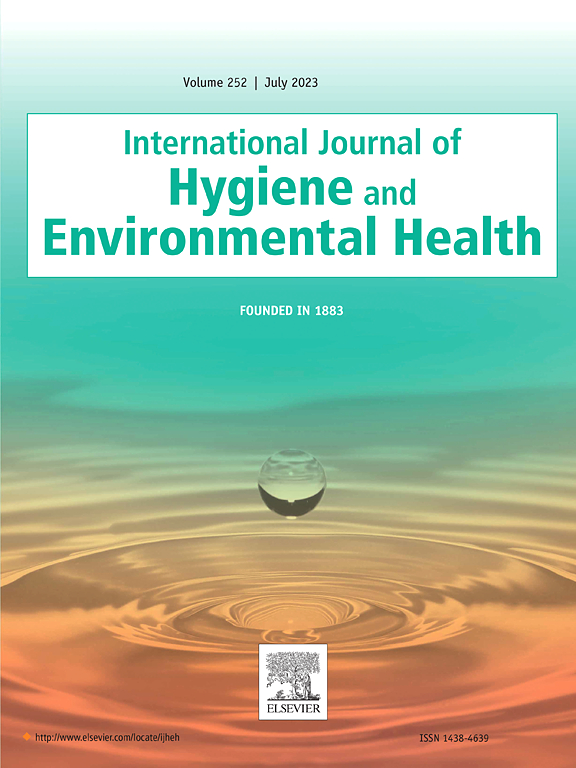Systematic review and meta-analysis of epidemiologic data on infectious disease in relation to exposure to twelve perfluoroalkyl substances (PFAS)
IF 4.4
2区 医学
Q1 INFECTIOUS DISEASES
International journal of hygiene and environmental health
Pub Date : 2025-04-03
DOI:10.1016/j.ijheh.2025.114571
引用次数: 0
Abstract
Background
While some per- and polyfluoroalkyl substances (PFAS) are immunosuppressants, whether they have an adverse effect on infectious disease morbidity is unclear. We conducted a systematic review and meta-analysis of epidemiologic data on the association between an incremental increase in serum concentration of any of 12 PFAS and the risk or rate of infectious disease (ID).
Methods
From 25 reports representing 18 unique study populations, we conducted meta-analyses stratified on exposure type (log-transformed or absolute scale) and outcome type (risk or rate). To synthesize data that could not be combined with meta-analysis due to different exposure or outcome types, we additionally conducted vote counting and calculated combined p-values.
Results
A small positive association between PFAS exposure and ID risk or rate was more frequently reported than not, though in the synthesized data statistical significance was present only in a few instances. The meta-analyses and combined p-value analyses had many similar findings. In the combined p-value analyses, statistically significant positive associations were noted between Perfluorononanoic acid and lower respiratory tract infection (LRTI) event rates, Perfluorooctanesulfonamide and LRTI event rates and LRTI risk and rates combined, Perfluorooctanoic acid and Perfluorodecanoic acid with all ID risk and rates combined, and Perfluoroundecanoic acid with all ID risk.
Conclusion
We identified moderate evidence of positive associations that were of variable size but usually small; the certainty of evidence was, however, generally low or very low and diminished by the possible influences of multiple testing and covariance among results not accounted for in the analyses.
Prospero registration
CRD42024551990.
与接触12种全氟烷基物质(PFAS)有关的传染病流行病学数据的系统评价和荟萃分析
虽然一些全氟和多氟烷基物质(PFAS)是免疫抑制剂,但它们是否对传染病发病率有不利影响尚不清楚。我们对12种PFAS中任何一种的血清浓度的增加与传染病(ID)的风险或发生率之间的关系进行了系统回顾和流行病学数据的荟萃分析。方法:从代表18个独特研究人群的25份报告中,我们对暴露类型(对数转换或绝对尺度)和结果类型(风险或发生率)进行了分层荟萃分析。为了综合由于不同暴露或结果类型而无法与meta分析结合的数据,我们额外进行了计票并计算了组合p值。结果PFAS暴露与ID风险或发生率之间存在较小的正相关,但在综合数据中仅在少数情况下存在统计学意义。荟萃分析和组合p值分析有许多相似的发现。在联合p值分析中,全氟壬烷酸与下呼吸道感染(LRTI)事件发生率、全氟辛烷磺酰胺与LRTI事件发生率、LRTI风险及合并发生率、全氟辛酸与全氟烷烃酸合并所有ID风险及合并发生率、全氟烷烃酸合并所有ID风险及合并发生率、全氟烷烃酸合并所有ID风险具有统计学意义的正相关。结论:我们发现了适度的正相关证据,这些证据大小不一,但通常很小;然而,证据的确定性通常较低或非常低,并且由于多重检验和分析中未考虑的结果之间的协方差的可能影响而降低。普洛斯彼罗registrationCRD42024551990。
本文章由计算机程序翻译,如有差异,请以英文原文为准。
求助全文
约1分钟内获得全文
求助全文
来源期刊
CiteScore
11.50
自引率
5.00%
发文量
151
审稿时长
22 days
期刊介绍:
The International Journal of Hygiene and Environmental Health serves as a multidisciplinary forum for original reports on exposure assessment and the reactions to and consequences of human exposure to the biological, chemical, and physical environment. Research reports, short communications, reviews, scientific comments, technical notes, and editorials will be peer-reviewed before acceptance for publication. Priority will be given to articles on epidemiological aspects of environmental toxicology, health risk assessments, susceptible (sub) populations, sanitation and clean water, human biomonitoring, environmental medicine, and public health aspects of exposure-related outcomes.

 求助内容:
求助内容: 应助结果提醒方式:
应助结果提醒方式:


